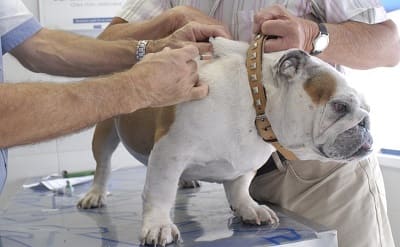Vaccines for Dogs
Vaccines for Dogs
Many times we are not clear about which diseases are included in the vaccination schedule for our dogs. Let’s analyze what they are in order to prevent them when vaccinating our pets in order to demonstrate how important vaccination is.

Regular Vaccines Schedule
– 6 WEEKS 👉 PUPPY (PD) DISTEMPER AND PARVOVIROSIS
– 8 WEEKS 👉 TETRAVALENT (DHPPI) DISTEMPER, HEPATITIS, PARVOVIROSIS AND PARAINFLUENZA
– 10 WEEKS 👉 2º TETRAVALENT, DISTEMPER, HEPATITIS, PARVOVIROSIS AND PARAINFLUENZA
– > 3 MONTHS 👉 WE WILL PUT THE RAGE TOGETHER WITH THE MICROCHIP
– ANNUAL 👉 HEPTAVALENT DISTEMPER, HEPATITIS, PARVOVIROSIS, PARAINFLUENZA AND RABIES
When an animal is sick we can never vaccinate it, we must wait for it to recover and wait 7 to 10 days so that we can start with the normal vaccination calendar protocol.
Let’s briefly see what the different diseases consist of in order to clarify why it is so important to keep our pets’ vaccination schedule up to date.
Vaccination Schedule Diseases
DISTEMPER
Distemper is a viral disease, caused by a specific virus (Paramyxovirus). It can become fatal and affects viscera and epithelial tissue.
We can find all these symptoms:
• hyperthermia
• Oculonasal catarrh
• Digestive symptoms
• Respiratory symptoms
• Nervous symptoms
• Skin symptoms
If the animal passes the disease and recovers, neurological sequelae may remain. The elimination of the virus is through sneezing, secretions and excretions of different types. Animals are usually infected through direct contact by the penetration of the virus via the nasal or conjunctival route.
PARVOVIROSIS
It is so named because it is caused by a parvovirus. It is clinically characterized by causing hemorrhagic gastroenteritis. It frequently affects young animals.
Symptomatology:
• Incubation occurs in 3-4 days
• Anorexy
• prostration
• vomiting
• Hemorrhagic diarrhea
• Significant dehydration
Infection occurs by fecal-oral route. Our pets smell and suck almost anything they find, so it is important that if our animal is not vaccinated because it is a puppy and is not yet immunized, we avoid contact with feces and uncontrolled dogs.
HEPATITIS
Contagious canine hepatitis is caused by the canine adenovirus Type I. The disease can be found but not manifested, however when it appears it does so as a systemic disease where we can find:
• hyperthermia
• Tonsillitis
• Inflammation of some lymph nodes (submandibular, prescapular)
• Stomach flu
• uveitis
Incubation occurs in 3-6 days and healing takes about 10. Virus elimination occurs through urine and lasts from 8 weeks to several months. Infection can occur directly or indirectly.
Others Vaccination Schedule Diseases
PARAINFLUENZA
This virus, together with the type II canine adenovirus and the Bordetella bronchiseptica bacterium, among others, are responsible for contagious canine tracheobronchitis, more commonly known as “kennel cough”.
Main symptoms:
• Tracheobronchitis
• conjunctivitis
• Rhinitis
• Tonsillitis
• Pharyngitis
Its contagion occurs through microscopic droplets that are transported through the air and that have been eliminated by affected animals. That is why this disease is usually observed more commonly in kennels, packs, farms or places where there is a large concentration of animals, hence its famous name.
RABIES
It is a ZOONOSIS, this means that it affects animals and humans in the same way, in fact it is a disease that affects all mammals. That is why it is so important.
Spain is declared free of rabies by the OIE (international organization of epizootics), but this does not mean that we should lower our guard and stop vaccinating. In fact, in June 2013, a focus of rabies was found in Toledo.
Currently, if a dog with rabies or with signs that it may have it is located, it will not be treated due to the high risk it poses to the population. It will be subjected to quarantine waiting to see clarifying signs or it will be directly sacrificed to analyze the brain, since this virus (rhabdovirus) has a preference for nervous tissue causing abnormal behavior, aggressiveness, photophobia, etc.
Other typical signs are animals that drool and with the muscles of the face in tension, all of which is also caused by the virus affecting the nervous system. All this class of symptomatology is the one that is usually related to rabid dogs.
The infection is caused by bites or scratches of sick animals that are in the neurological phase.
Vaccination against this disease is not the same throughout the Spanish territory, for example in Madrid it is compulsory but in Catalonia it is not. The current legislation is not unified and powers are transferred to the different autonomous communities.



